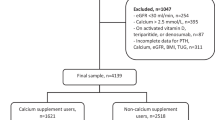Abstract
Background Patients with advanced cancers are at high risk for bone metastases, which accelerate bone resorption and skeletal complications. Therefore, bisphosphonates, which are strong inhibitors of bone resorption, are widely used to prevent pathological fractures, pain and tumour-induced hypercalcaemia. Intravenous infusion of bisphosphonate is associated with dose- and infusion rate-dependent adverse renal effects. Objective The present study investigated the effect of hydration on bisphosphonate efficacy and safety. Settings The 600-bed CHOV Hospital (Neufchâteau, France) and the Université de Lorraine (Nancy, France). Methods Patients who received pamidronate or zoledronic acid treatments were identified: 50 patients [16 of whom were hydrated and 34 of whom were non-hydrated]. Data on serum calcium levels, creatinine clearance and clinical tolerance were collected. Main outcome measure The impact of hydration on these parameters was analysed between day 1 and day 7. Results Bisphosphonate normalized calcaemia and hydration did not induce further reduction of calcium levels. Patient kidneys were significantly preserved by hydration in both groups (median clearance: +6.2 %), whereas dehydrated patients had lower creatinine clearance (median clearance: −1.1 %). Hydration did not influence other clinical or biological parameters tested. Conclusion Hydration plays an important role in the treatment of hypercalcaemia by pamidronate and zoledronic acid: it enhances kidney protection (i.e., creatinine clearance).


Similar content being viewed by others
References
Stewart A. Hypercalcemia associated with cancer. N Engl J Med. 2005;352:373–9.
U.S. Food and Drug Administration. Zoledronic acid for osteoporosis (marketed as reclast). In: FDA editor. Drug safety newsletter, vol 2(2). Silver Spring: FDA; 2009. p. 16–8.
Actonel®—Prescribing information. 2013. http://www.actonel.com/global/prescribing_information.pdf. Accessed 10 April 2014.
Boniva®—Prescribing information. 2010. http://www.accessdata.fda.gov/drugsatfda_docs/label/2010/021455s009lbl.pdf. Accessed 10 April 2014.
Fosamax®—Prescribing information. 2013. http://www.merck.com/product/usa/pi_circulars/f/fosamax/fosamax_pi.pdf. Accessed 10 April 2014.
Reclast®—Prescribing information. 2013. http://www.pharma.us.novartis.com/product/pi/pdf/reclast.pdf. Accessed 10 April 2014.
Markowitz GS, Appel GB, Fine PL, Fenves AZ, Loon NR, Jagannath S, et al. Collapsing focal segmental glomerulosclerosis following treatment with high dose pamidronate. J Am Soc Nephrol. 2001;12:1164–72.
Tralongo P, Repetto L, Di Mari A, Mauceri G, Bollina R, Ferrau F, et al. Safety of long-term administration of bisphosphonates in elderly cancer patients. Oncology. 2004;67:112–6.
Ali SM, Esteva FJ, Hortobagyi G, Harvey H, Seaman J, Knight R, et al. Safety and efficacy of bisphosphonates beyond 24 months in cancer patients. J Clin Oncol. 2001;19:3434–7.
Lumachi F, Brunello A, Roma A, Basso U. Cancer-induced hypercalcemia. Anticancer Res. 2009;29:1551–5.
LeGrand SB. Narrative review: furosemide for hypercalcemia: an unproven yet common practice. Ann Intern Med. 2008;149:259–63.
Fisken RA, Heath DA, Bold AM. Hypercalcaemia—a hospital survey. QJM-Int J Med. 1980;49:405–18.
Russell RG, Watts NB, Ebetino FH, Rogers MJ. Mechanisms of action of bisphosphonates: similarities and differences and their potential influence on clinical efficacy. Osteoporos Int. 2008;19:733–59.
Luhe A, Kunkele KP, Haiker M, Schad K, Zihlmann C, Bauss F, et al. Preclinical evidence for nitrogen-containing bisphosphonate inhibition of farnesyl diphosphate (FPP) synthase in the kidney: implications for renal safety. Toxicol In Vitro. 2008;22:899–909.
Bounameaux HM, Schifferli J, Montani JP, Jung A, Chatelanat F. Renal failure associated with intravenous diphosphonates. Lancet. 1983;1:471.
Fleisch H. Bisphosphonates: mechanisms of action. Endocr Rev. 1998;19:80–100.
Green JR, Seltenmeyer Y, Jaeggi KA, Widler L. Renal tolerability profile of novel, potent bisphosphonates in two short-term rat models. Pharmacol Toxicol. 1997;80:225–30.
Markowitz GS, Fine PL, Stack JI, Kunis CL, Radhakrishnan J, Palecki W, et al. Toxic acute tubular necrosis following treatment with zoledronate (Zometa). Kidney Int. 2003;64:281–9.
Bodmer M, Amico P, Mihatsch MJ, Haschke M, Kummer O, Krahenbuhl S, et al. Focal segmental glomerulosclerosis associated with long-term treatment with zoledronate in a myeloma patient. Nephrol Dial Transplant. 2007;22:2366–70.
Henley D, Kaye J, Walsh J, Cull G. Symptomatic hypocalcaemia and renal impairment associated with bisphosphonate treatment in patients with multiple myeloma. Intern Med J. 2005;35:726–8.
Solomon R, Werner C, Mann D, D’Elia J, Silva P. Effects of saline, mannitol, and furosemide to prevent acute decreases in renal function induced by radiocontrast agents. N Engl J Med. 1994;331:1416–20.
Acknowledgments
We thank all physicians and nurses who helped us for this study.
Funding
None.
Conflicts of interest
None.
Author information
Authors and Affiliations
Corresponding author
Rights and permissions
About this article
Cite this article
Attivi, D., Kosmalski, G., Zeghmouli, C. et al. Effect of intravenous hydration in patients receiving bisphosphonate therapy. Int J Clin Pharm 36, 1277–1281 (2014). https://doi.org/10.1007/s11096-014-9994-x
Received:
Accepted:
Published:
Issue Date:
DOI: https://doi.org/10.1007/s11096-014-9994-x




